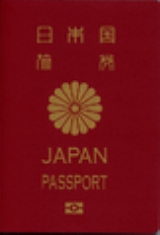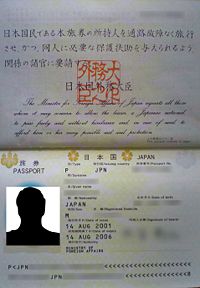
Japanese passport
Encyclopedia
Japanese passports are issued to Japanese citizens to travel outside Japan
.
All Japanese passports issued after March 20, 2006 are biometric passport
s.
 Japanese passports have the Imperial Seal of Japan
Japanese passports have the Imperial Seal of Japan
inscribed in the center of the front cover, with the Japanese
words Nipponkoku Ryoken (日本国旅券) inscribed above and its English
translation JAPAN PASSPORT below the Seal. Ordinary passports valid for five years are in dark blue, and those valid for ten years are in crimson
in color. Additionally, official passports are in dark green, and diplomatic passports in dark brown.
Also, beneath these is the machine readable zone.
In Japanese
:
In English
:
and English
, except for the note of caution that is found at the end of the passport (e.g. on page 51 of the ten-year biometric ordinary passport), which is only printed in Japanese
. This note contains information about what the bearer should know when encountering various situations in a foreign country.
The surname, given name and other personalized mentions (like registered domicile) are only indicated in Latin uppercase letters. Japanese names are in principle transcribed according to the Hepburn romanization
system, but exceptions are admitted in certain cases, notably when the name is the katakana
transcription of a foreign name (Japanese spouse or Japanese child of a foreigner), in which case the original spelling of the name in the Latin alphabet may be used, only if you submit the official document with the original spelling issued by the government (passport etc).
The signature may be written in any language and in any spelling the individual desires.
Japan
Japan is an island nation in East Asia. Located in the Pacific Ocean, it lies to the east of the Sea of Japan, China, North Korea, South Korea and Russia, stretching from the Sea of Okhotsk in the north to the East China Sea and Taiwan in the south...
.
Types of passports
- Ordinary passport: Issued to normal citizens.
- Ordinary passports are issued in two different lengths of validity: five and ten years. Japanese citizens up to 19 years of age can only be issued a five-year passport, while those who are 20 years of age or older can choose either a five-year (blue) or ten-year (red) passport for different registration fees.
- Official passport: Issued to members of the DietDiet of JapanThe is Japan's bicameral legislature. It is composed of a lower house, called the House of Representatives, and an upper house, called the House of Councillors. Both houses of the Diet are directly elected under a parallel voting system. In addition to passing laws, the Diet is formally...
and public servantsCivil serviceThe term civil service has two distinct meanings:* A branch of governmental service in which individuals are employed on the basis of professional merit as proven by competitive examinations....
. - Diplomatic passport: Issued to members of the Imperial FamilyImperial House of JapanThe , also referred to as the Imperial Family or the Yamato Dynasty, comprises those members of the extended family of the reigning Emperor of Japan who undertake official and public duties. Under the present Constitution of Japan, the emperor is the symbol of the state and unity of the people...
, diplomats and their family members and government high-level officials.- By convention, Japan's EmperorEmperor of JapanThe Emperor of Japan is, according to the 1947 Constitution of Japan, "the symbol of the state and of the unity of the people." He is a ceremonial figurehead under a form of constitutional monarchy and is head of the Japanese Imperial Family with functions as head of state. He is also the highest...
and EmpressJapanese empressesIn Japan, empress may refer to either or .- Empresses regnant :There were eight female imperial reigns in Japan's early history between 593 and 770, and two more in the early modern period...
do not hold a passport.
- By convention, Japan's Emperor
All Japanese passports issued after March 20, 2006 are biometric passport
Biometric passport
A biometric passport, also known as an e-passport or ePassport, is a combined paper and electronic passport that contains biometric information that can be used to authenticate the identity of travelers...
s.
Physical appearance

Imperial Seal of Japan
The Imperial Seal of Japan is a mon or crest used by members of the Japanese Imperial family. Under the Meiji Constitution, no one was permitted to use the Imperial Seal except the Emperor of Japan, who used a 16 petal chrysanthemum with sixteen tips of another row of petals showing behind the...
inscribed in the center of the front cover, with the Japanese
Japanese language
is a language spoken by over 130 million people in Japan and in Japanese emigrant communities. It is a member of the Japonic language family, which has a number of proposed relationships with other languages, none of which has gained wide acceptance among historical linguists .Japanese is an...
words Nipponkoku Ryoken (日本国旅券) inscribed above and its English
English language
English is a West Germanic language that arose in the Anglo-Saxon kingdoms of England and spread into what was to become south-east Scotland under the influence of the Anglian medieval kingdom of Northumbria...
translation JAPAN PASSPORT below the Seal. Ordinary passports valid for five years are in dark blue, and those valid for ten years are in crimson
Crimson
Crimson is a strong, bright, deep red color. It is originally the color of the dye produced from a scale insect, Kermes vermilio, but the name is now also used as a generic term for those slightly bluish-red colors that are between red and rose; besides crimson itself, these colors include...
in color. Additionally, official passports are in dark green, and diplomatic passports in dark brown.
Identity information page
- Photograph of passport holder
- Type
- Issuing country
- Passport number
- Surname
- Given name
- Nationality
- Date of birth
- Sex
- Registered Domicile
- Date of issue
- Date of expiry
- Issuing authority
- Signature of bearer
Also, beneath these is the machine readable zone.
Passport note
The passports contain a note from the issuing country that is addressed to the authorities of all other countries, identifying the bearer as a citizen of that country and requesting that he or she be allowed to pass and be treated according to international norms. The note inside of Japanese passports states:In Japanese
Japanese language
is a language spoken by over 130 million people in Japan and in Japanese emigrant communities. It is a member of the Japonic language family, which has a number of proposed relationships with other languages, none of which has gained wide acceptance among historical linguists .Japanese is an...
:
-
- 日本国民である本旅券の所持人を通路故障なく旅行させ、かつ、同人に必要な保護扶助を与えられるよう、関係の諸官に要請する。
In English
English language
English is a West Germanic language that arose in the Anglo-Saxon kingdoms of England and spread into what was to become south-east Scotland under the influence of the Anglian medieval kingdom of Northumbria...
:
-
- The Minister for Foreign Affairs of Japan requests all those whom it may concern to allow the bearer, a Japanese national, to pass freely and without hindrance and, in case of need, to afford him or her every possible aid and protection.
Language
Japanese passports are entirely printed in both JapaneseJapanese language
is a language spoken by over 130 million people in Japan and in Japanese emigrant communities. It is a member of the Japonic language family, which has a number of proposed relationships with other languages, none of which has gained wide acceptance among historical linguists .Japanese is an...
and English
English language
English is a West Germanic language that arose in the Anglo-Saxon kingdoms of England and spread into what was to become south-east Scotland under the influence of the Anglian medieval kingdom of Northumbria...
, except for the note of caution that is found at the end of the passport (e.g. on page 51 of the ten-year biometric ordinary passport), which is only printed in Japanese
Japanese language
is a language spoken by over 130 million people in Japan and in Japanese emigrant communities. It is a member of the Japonic language family, which has a number of proposed relationships with other languages, none of which has gained wide acceptance among historical linguists .Japanese is an...
. This note contains information about what the bearer should know when encountering various situations in a foreign country.
The surname, given name and other personalized mentions (like registered domicile) are only indicated in Latin uppercase letters. Japanese names are in principle transcribed according to the Hepburn romanization
Hepburn romanization
The is named after James Curtis Hepburn, who used it to transcribe the sounds of the Japanese language into the Latin alphabet in the third edition of his Japanese–English dictionary, published in 1887. The system was originally proposed by the in 1885...
system, but exceptions are admitted in certain cases, notably when the name is the katakana
Katakana
is a Japanese syllabary, one component of the Japanese writing system along with hiragana, kanji, and in some cases the Latin alphabet . The word katakana means "fragmentary kana", as the katakana scripts are derived from components of more complex kanji. Each kana represents one mora...
transcription of a foreign name (Japanese spouse or Japanese child of a foreigner), in which case the original spelling of the name in the Latin alphabet may be used, only if you submit the official document with the original spelling issued by the government (passport etc).
The signature may be written in any language and in any spelling the individual desires.
See also
- Visa requirements for Japanese citizensVisa requirements for Japanese citizensIt is estimated that 184 countries and territories granted visa-free or visa-on-arrival access to ordinary Japanese passport holders. According to the "Henley Visa Restrictions Index 2011," 170 countries and territories are visa-free accessible. Visa prior to arrival or pre-arrangement required...
- Foreign relations of JapanForeign relations of JapanForeign relations of Japan is handled by the Ministry of Foreign Affairs of Japan.Since the surrender after World War II and the Treaty of San Francisco, Japanese diplomatic policy has been based on close partnership with the United States and the emphasis on the international cooperation such as...
- Japanese nationality lawJapanese nationality lawJapanese nationality is a legal designation and set of rights granted to those people who have met the federal criteria for citizenship by parentage or by naturalization...

